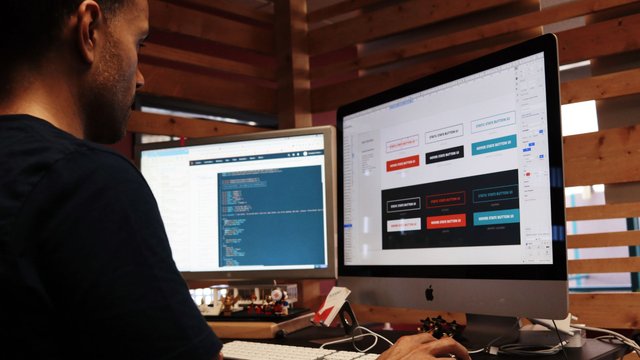
As we stand at the intersection of technological innovation and web design, Artificial Intelligence (AI) emerges as a transformative force reshaping the way we conceptualize, create, and interact with websites. This comprehensive guide explores the integration of AI in website design, unraveling the profound impact it has on user experiences, design processes, and the overall digital landscape.
Understanding AI in Website Design
1. Defining AI in Web Design
Artificial Intelligence refers to the simulation of human intelligence in machines, enabling them to perform tasks that typically require human intelligence, such as problem-solving, learning, and decision-making. In the context of web design, AI becomes a dynamic tool that augments the capabilities of designers and enhances the functionality of websites.
2. The Role of AI in Enhancing User Experiences
Personalization and User Engagement
AI-driven personalization algorithms analyze user behavior, preferences, and demographics to deliver tailored content and recommendations. This enhances user engagement by presenting relevant information, products, or services, fostering a sense of connection and relevance.
Chatbots and Virtual Assistants
Incorporating AI-powered chatbots and virtual assistants enhances user interactions by providing instant support, answering queries, and guiding users through various processes. Natural Language Processing (NLP) enables these virtual entities to understand and respond to user inputs in a conversational manner.
Predictive Analytics for User Behavior
AI utilizes predictive analytics to anticipate user behavior based on historical data. This insight allows designers to optimize website layouts, calls to action, and content placement, creating a more intuitive and user-friendly experience.
At SFWPExperts - as a reputed website design company, we pioneer the convergence of creativity and technology, harnessing the power of Artificial Intelligence (AI) to redefine website design. Our commitment to innovation extends beyond aesthetics, as we leverage AI to craft intelligent, personalized, and cutting-edge web design experiences that captivate audiences and propel businesses into the digital future.
Implementing AI in the Design Process

1. AI-Powered Design Assistance
Automated Design Suggestions
AI tools offer automated design suggestions by analyzing design trends, user preferences, and industry standards. Designers can leverage these suggestions to enhance their creativity, streamline workflows, and ensure their designs align with contemporary aesthetics.
Generative Design
Generative design, powered by AI algorithms, explores multiple design possibilities based on specified criteria. This iterative process generates diverse design options, enabling designers to explore innovative solutions and push the boundaries of conventional design.
Related Post:What Is Generative AI? How It Works With Website Design
2. AI for Content Creation
Image and Video Enhancement
AI algorithms can enhance the quality of images and videos by adjusting colors, improving resolution, and reducing noise. This ensures visually appealing multimedia content that captivates users and communicates brand messages effectively.
Content Generation and Summarization
AI-driven content generation tools assist in creating text content, automating routine writing tasks, and even summarizing lengthy articles. This accelerates content creation processes while maintaining quality and relevance.
Related Post:Inbound Marketing Series: 7 Basic Steps Of Content Creation
AI-Infused Website Functionalities
1. Search Engine Optimization (SEO) Optimization
AI-Driven SEO Strategies
AI analyzes search patterns, user intent, and content relevance to optimize websites for search engines. This results in improved SEO performance, higher visibility in search results, and increased organic traffic.
Intelligent Content Tagging
AI automates the process of content tagging, ensuring that web pages are correctly categorized and indexed by search engines. This enhances the discoverability of content and contributes to a more efficient SEO strategy.
2. AI in E-Commerce Website Design

Dynamic Product Recommendations
E-commerce websites leverage AI to provide dynamic and personalized product recommendations based on user browsing history, purchase behavior, and preferences. This boosts cross-selling and upselling opportunities, increasing overall sales.
AI-Powered Visual Search
Visual search functionalities, powered by AI, enable users to search for products using images rather than text. This intuitive feature enhances the user experience and facilitates quicker and more accurate product discovery.
Overcoming Challenges in AI-Integrated Web Design
1. Ethical Considerations
Data Privacy and Security
AI relies heavily on data, raising concerns about user privacy and data security. Implementing robust data protection measures and transparent privacy policies is crucial to address these ethical considerations.
Bias in AI Algorithms
AI algorithms may inherit biases present in the data they are trained on. Web designers must actively address and mitigate biases to ensure fair and inclusive AI-driven experiences.
2. Technical Complexity
Skill Requirements
Implementing AI in web design demands a certain level of technical expertise. Designers and developers need to acquire the necessary skills or collaborate with AI specialists to successfully integrate AI into their projects.
Integration Challenges
Integrating AI tools into existing web design workflows can pose challenges. Compatibility issues, technical constraints, and the need for seamless integration with other technologies require careful consideration.
Realizing the Future of AI-Driven Web Design
1. Continuous Learning and Adaptation
AI as a Design Assistant
As AI evolves, it is positioned to become an even more integral part of the design process, serving as a design assistant that continuously learns from user interactions and design trends to offer increasingly refined suggestions.
Evolution of AI Algorithms
AI algorithms will continue to advance, providing designers with more sophisticated tools for pattern recognition, predictive design analysis, and creative inspiration. This evolution promises to redefine the boundaries of what is achievable in web design.
2. Democratization of AI Tools
Accessibility for Designers
The democratization of AI tools ensures that designers of varying skill levels can access and benefit from AI-driven functionalities. User-friendly interfaces and intuitive design tools make AI integration more accessible to a broader audience.
AI-Driven Design Platforms
Design platforms that seamlessly integrate AI capabilities will become standard tools in the web design service. These platforms will empower designers to create innovative and personalized user experiences with ease.
Case Studies: AI in Action
1. Netflix - Personalized Content Recommendations
Netflix employs AI algorithms to analyze user viewing patterns and preferences, delivering personalized content recommendations. This AI-driven approach enhances user satisfaction and encourages prolonged engagement on the platform.
2. The Grid - AI-Generated Website Design
The Grid utilizes AI algorithms to automatically generate website designs based on user preferences and content inputs. This AI-driven design platform streamlines the website creation process, providing users with unique and visually appealing designs.
Conclusion: Embracing the AI Revolution in Web Design
As AI continues to permeate the fabric of web design, its transformative influence becomes increasingly undeniable. The symbiotic relationship between AI and web design promises a future where websites are not only aesthetically pleasing but also intuitively responsive to user needs. Embracing the AI revolution in web design positions designers, businesses, and users at the forefront of a digital era defined by innovation, personalization, and unparalleled user experiences. The journey towards a harmonious integration of AI and web design is not just a leap into the future; it's a step towards redefining the very essence of the online landscape.
Read More Articles:
Best Practices For WordPress Website Design: Crafting An Exceptional Online Presence
Empowering Your Online Store: Unleashing the Potential of eCommerce Website Builders
Advanced Custom Fields 6.0: Elevating WordPress Website Design for the Modern Era
Key Considerations In Web Design For 2024: Navigating the Future of Digital Experiences